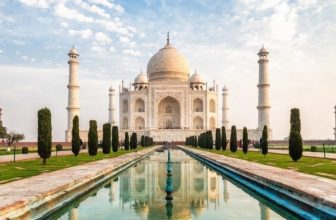Monday Flashback Story: Ajanta Caves – Sustainable Monuments & Architecture from 2nd Century BCE
This week in the Monday Flashback story, we present the Flashback story of Ajanta Caves. The Buddhist Caves in Ajanta are approximately 30 rock-cut Buddhist cave monuments dating from the 2nd century BCE to about 480 CE in the Aurangabad district of Maharashtra state in India. The caves include paintings and rock-cut sculptures described as among the finest surviving examples of ancient Indian art, particularly expressive paintings that present emotions through gesture, pose, and form.
They are universally regarded as masterpieces of Buddhist religious art. The caves were built in two phases, the first starting around the 2nd century BCE and the second occurring from 400 to 650 CE, according to older accounts, or in a brief period of 460–480 CE according to later scholarship. The site is a protected monument in the care of the Archaeological Survey of India, and since 1983, the Ajanta Caves have been a UNESCO World Heritage Site.
The Ajanta Caves constitute ancient monasteries and worship halls of different Buddhist traditions carved into a 75-meter (246 ft) wall of rock. The caves also present paintings depicting the past lives and rebirths of the Buddha, pictorial tales from Aryasura’s Jatakamala, and rock-cut sculptures of Buddhist deities. Textual records suggest that these caves served as a monsoon retreat for monks, as well as a resting site for merchants and pilgrims in ancient India. While vivid colors and mural wall-painting were abundant in Indian history as evidenced by historical records, Caves 16, 17, 1, and 2 of Ajanta form the largest corpus of surviving ancient Indian wall-painting.
The UN World Commission on Environment and Development has stated that in order to be sustainable one has to “meet the needs of the present without compromising the ability of future generations, to meet their own needs, especially with regards to use and waste of natural resources.” Keeping this mind in the last few decades there has been an increasing number of “Green buildings” that are designed in a way which keeps them in sync with sustainable environmental development.
Interestingly, the idea behind these “Green buildings” are not new, and date back to the ancient times, when available natural resources were used efficiently, avoiding unnecessary wastages. Indigenous materials specific to the locations were used in order to keep the houses warm or cool based on the climatic zones, while elaborate sewage and water supply systems were built with the available natural materials.
The Ajanta caves, which form a series of 29 rock-cut caves from ancient India, demonstrate how the architects of those times would make optimal use of the available natural resources at hand. The vaulted ceilings of these rock-cut caves had sun windows that would light up the prayer halls naturally.
The Ajanta caves, unlike other rock-cut caves, have low ceilings which were specifically designed to allow hot air from prayer halls to rise and move into the surrounding cells that held cool water. This hot air would then be cooled naturally, leading to the cooling of the entire cave.

The caves are carved out of flood basalt rock of a cliff, part of the Deccan Traps formed by successive volcanic eruptions at the end of the Cretaceous geological period. The rock is layered horizontally, and somewhat variable in quality. This variation within the rock layers required the artists to amend their carving methods and plans in places. The inhomogeneity in the rock has also led to cracks and collapses in the centuries that followed, as with the lost portico to cave 1. Excavation began by cutting a narrow tunnel at roof level, which was expanded downwards and outwards; as evidenced by some of the incomplete caves such as the partially-built vihara caves 21 through 24 and the abandoned incomplete cave 28.
The sculpture artists likely worked at both excavating the rocks and making the intricate carvings of pillars, roofs, and idols; further, the sculpture and painting work inside a cave were integrated parallel tasks. A grand gateway to the site was carved, at the apex of the gorge’s horseshoe between caves 15 and 16, as approached from the river, and it is decorated with elephants on either side and a nāga, or protective Naga (snake) deity. Similar methods and applications of artist talent are observed in other cave temples of India, such as those from Hinduism and Jainism. These include the Ellora Caves, Ghototkacha Caves, Elephanta Caves, Bagh Caves, Badami Caves, Aurangabad Caves and Shivleni Caves.
The caves from the first period seem to have been paid for by a number of different patrons to gain merit, with several inscriptions recording the donation of particular portions of a single cave. The later caves were each commissioned as a complete unit by a single patron from the local rulers or their court elites, again for merit in Buddhist afterlife beliefs as evidenced by inscriptions such as those in Cave 17. After the death of Harisena, smaller donors motivated by getting merit added small “shrinelets” between the caves or add statues to existing caves, and some two hundred of these “intrusive” additions were made in sculpture, with a further number of intrusive paintings, up to three hundred in cave 10 alone.
 Formed from a single block of excavated stone, the Kailasa temple is considered one of the most impressive cave temples in India. The enormous structure is one of 34 cave temples and monasteries that are collectively known as the Ellora Caves. Located in the western region of Maharashtra, the caves are a UNESCO World Heritage Site and include monuments dating between 600 and 1000 CE. While there are many impressive structures on-site, it’s the megalithic Kailasa temple that is perhaps the most well-known.
Formed from a single block of excavated stone, the Kailasa temple is considered one of the most impressive cave temples in India. The enormous structure is one of 34 cave temples and monasteries that are collectively known as the Ellora Caves. Located in the western region of Maharashtra, the caves are a UNESCO World Heritage Site and include monuments dating between 600 and 1000 CE. While there are many impressive structures on-site, it’s the megalithic Kailasa temple that is perhaps the most well-known.Cave 1 was built on the eastern end of the horseshoe-shaped scarp and is now the first cave the visitor encounters. This cave, when first made, would have been in a less prominent position, right at the end of the row. According to Spink, it is one of the last caves to have been excavated, when the best sites had been taken and was never fully inaugurated for worship by the dedication of the Buddha image in the central shrine. This is shown by the absence of sooty deposits from butter lamps on the base of the shrine image, and the lack of damage to the paintings that would have happened if the garland hooks around the shrine had been in use for any period of time. Spink states that the Vākāṭaka Emperor Harishena was the benefactor of the work, and this is reflected in the emphasis on the imagery of royalty in the cave, with those Jataka tales being selected that tell of those previous lives of the Buddha in which he was royal.
The cliff has a more steep slope here than at other caves, so to achieve a tall grand facade it was necessary to cut far back into the slope, giving a large courtyard in front of the facade. There was originally a columned portico in front of the present facade, which can be seen “half-intact in the 1880s” in pictures of the site, but this fell down completely and the remains, despite containing fine carvings, were carelessly thrown down the slope into the river, from where they have been lost.

The frieze over the frontage of Cave 1 front shows elephants, horses, bulls, lions, apsaras and meditating monks.
This cave (35.7 m × 27.6 m)[114] has one of the most elaborate carved façades, with relief sculptures on entablature and ridges, and most surfaces embellished with decorative carving. There are scenes carved from the life of the Buddha as well as a number of decorative motifs. A two-pillared portico, visible in the 19th-century photographs, has since perished. The cave has a frontcourt with cells fronted by pillared vestibules on either side. These have a high plinth level.The cave has a porch with simple cells on both ends. The absence of pillared vestibules on the ends suggests that the porch was not excavated in the latest phase of Ajanta when pillared vestibules had become customary. Most areas of the porch were once covered with murals, of which many fragments remain, especially on the ceiling. There are three doorways: a central doorway and two side doorways. Two square windows were carved between the doorways to brighten the interiors.
Each wall of the hall inside is nearly 40 feet (12 m) long and 20 feet (6.1 m) high. Twelve pillars make a square colonnade inside supporting the ceiling and creating spacious aisles along the walls. There is a shrine carved on the rear wall to house an impressive seated image of the Buddha, his hands being in the dharma chakrapra Vartan mudra. There are four cells on each of the left, rear, and right walls, though due to rock fault there are none at the ends of the rear aisle.
The paintings of Cave 1 cover the walls and the ceilings. They are in a fair state of preservation, although the full scheme was never completed. The scenes depicted are mostly didactic, devotional, and ornamental, with scenes from the Jataka stories of the Buddha’s former lives as a bodhisattva, the life of the Gautama Buddha, and those of his generation. The two most famous individual painted images at Ajanta are the two over-life-size figures of the protective bodhisattvas Padmapani and Vajrapani on either side of the entrance to the Buddha shrine on the wall of the rear aisle (see illustrations above). Other significant frescos in Cave 1 include the Sibi, Sankhapala, Mahajanaka, Mahaummagga, and Champeyya Jataka tales. The cave paintings also show the Temptation of Mara, the miracle of Sravasti where the Buddha simultaneously manifests in many forms, the story of Nanda, and the story of Siddhartha and Yasodhara.


Several other caves were also built in Western India around the same period under royal sponsorship. It is thought that the chronology of these early Chaitya Caves is as follows: first Cave 9 at Kondivite Caves and then Cave 12 at the Bhaja Caves, which both predate Cave 10 of Ajanta. Then, after Cave 10 of Ajanta, in chronological order: Cave 3 at Pitalkhora, Cave 1 at Kondana Caves, Cave 9 at Ajanta, which, with its more ornate designs, may have been built about a century later, Cave 18 at Nasik Caves, and Cave 7 at Bedse Caves, to finally culminate with the “final perfection” of the Great Chaitya at Karla Caves.
To many who are unaware of the premises of Indian religions in general and Buddhism in particular, the significance of Ajanta Caves has been like the rest of Indian art. According to Richard Cohen, Ajanta Caves to them has been yet another example of “worship this stock, or that stone, or monstrous idol”. In contrast, to the Indian mind and the larger Buddhist community, it is everything that art ought to be, the religious and the secular, the spiritual and the social fused to enlightened perfection.
According to Walter Spink – one of the most respected Art historians on Ajanta, these caves were by 475 CE a much-revered site to the Indians, with throngs of “travelers, pilgrims, monks, and traders”. The site was vastly transformed into its current form in just 20 years, between early 460 CE to early 480 CE, by regional architects and artisans. This accomplishment, states Spink, makes Ajanta, “one of the most remarkable creative achievements in man’s history”.







